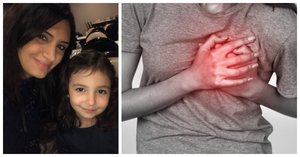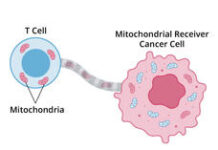When Cindy Karadsheh Soave was 36 and pregnant with her second child, she found a lump in her breast.Like too many stories we hear, her concerns were initially dismissed because her doctor assumed it was a clogged milk duct.“I couldn’t get a mammogram because of the pregnancy,” Soave told Michigan Health. “But I visited my doctor again and pressured him to do another exam, because I knew something was wrong.”Following her gut instincts proved right. Soave was soon diagnosed with hormone receptor-positive and HER2-positive breast cancer. Photo: Adobe Stock/mikumistock
Photo: Adobe Stock/mikumistock
Soave began chemotherapy in her second trimester, completing her first round in October. Her baby girl was born in November, and she and the babe were able to go home. Things were looking up.But in January, Soave developed a persistent cough and her pulse spiked too high, clipping along at 120. (A normal resting heart rate is typically between 60 and 100 beats per minute.)Again following her gut instinct, she headed to the ER — where she discovered she was in heart failure. Photo: Facebook/Cindy Karadsheh Soave
Photo: Facebook/Cindy Karadsheh Soave
Soave was only in her mid-thirties, but her heart muscle had become significantly weakened, most likely due to her cancer treatment.Soave halted anticancer therapy due to its potentially detrimental effect on her heart. She began taking heart medication instead.“I couldn’t believe how quickly my life changed,” Soave said. “I had been perfectly healthy my whole life, never took medication for anything, and now I’m losing my hair, in and out of hospitals, and I could die from the cancer I can’t treat anymore, if not heart failure.”Her situation continued to worsen. Photo: Adobe Stock/mykolasamoilenk
Photo: Adobe Stock/mykolasamoilenk
The left side of her heart was so damaged that she was told she would need a left ventricular assist device (LVAD) implanted. Then, another surgeon found that the right side of her heart was also damaged — enough so that she would also need a right ventricular assist device (RVAD).She wasn’t eligible for a heart transplant because of her cancer.She underwent surgery to implant both devices, something only 3% of patients require at the same time, according to her doctor, Matthew Konerman, M.D., a cardiologist at the Frankel Cardiovascular Center.The thing is, RVAD devices aren’t allowed for outpatient use. So Soave had to spend the foreseeable future in the hospital, hoping her heart would recover. Photo: Facebook/Cindy Karadsheh Soave
Photo: Facebook/Cindy Karadsheh Soave
After two months, while still in the ICU for her heart condition, Soave underwent a mastectomy.“The bad news never ended,” says Soave. “It was the true definition of a nightmare and I had no idea what life would be like after this.”Finally, after months of waiting, doctors found that her right ventricle was recovering. She had the RVAD removed successfully and was discharged. She was finally able to be home with her family. Photo: Adobe Stock/xixinxingA few months later, more good news: her left ventricle was also recovering. Her LVAD could potentially be removed soon as well!“We do not commonly see heart function improve to allow for LVAD removal. LVAD therapy is usually a bridge to heart transplant or a permanent therapy. This was a rare case,” Konerman said.
Photo: Adobe Stock/xixinxingA few months later, more good news: her left ventricle was also recovering. Her LVAD could potentially be removed soon as well!“We do not commonly see heart function improve to allow for LVAD removal. LVAD therapy is usually a bridge to heart transplant or a permanent therapy. This was a rare case,” Konerman said.
However, more bad news was in store for her.She had a transient ischemic attack (mini-stroke). Shortly after that, she had a subarachnoid hemorrhage, (an aneurysm rupture) which triggered bleeding in her brain. She went back to the hospital again, for another long stay. Photo: Facebook/Cindy Karadsheh SoaveThe strokes had caused her speech to become slurred, and the left side of her body had lost all sensation. After months of teaching herself to walk and feed herself again, she had her third heart surgery in a year and the LVAD was removed.Soave is home now and doing well. She currently has no symptoms of any cardiac conditions and no signs of breast cancer in her body.
Photo: Facebook/Cindy Karadsheh SoaveThe strokes had caused her speech to become slurred, and the left side of her body had lost all sensation. After months of teaching herself to walk and feed herself again, she had her third heart surgery in a year and the LVAD was removed.Soave is home now and doing well. She currently has no symptoms of any cardiac conditions and no signs of breast cancer in her body.
“I feel so blessed to experience God’s healing. That I could be a testimony for being your own biggest healthcare advocate,” Soave said. “I didn’t always understand the pain and suffering, but it was my job to persevere.”Source







